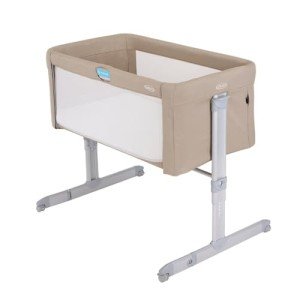Think You're Cut Out For Doing Attachable Bedside Crib? Answer This Question

Understanding Co-Sleeper Cribs: A Comprehensive Guide for New Parents
In the ever-evolving landscape of infant sleep solutions, co-sleeper cribs have actually garnered considerable attention amongst new parents. These specialized cribs use a special bridge in between co-sleeping and safe sleep practices, providing benefits that resonate with both caregivers and infants. This short article looks into the complexities of co-sleeper cribs, outlining their features, advantages, factors to consider, and answering typical questions to direct parents in making a notified choice.
What is a Co-Sleeper Crib?
A co-sleeper crib, also referred to as a bedside sleeper, is a kind of crib designed to securely connect or sit next to an adult bed. It allows infants to sleep near their parents without the threats traditionally associated with adult bed-sharing. These cribs can be found in numerous designs, however the majority of share an essential feature: one side that is lower, allowing easy reach to the baby while keeping them in their own designated sleeping space.
Key Features of Co-Sleeper Cribs
- Safe Attachment: Designed to safely connect to the adult bed, ensuring stability.
- Adjustable Height: Height personalization options for smooth placing beside the adult mattress.
- Breathable Mesh Sides: Often equipped with breathable mesh sides to improve air flow.
- Compact Design: Takes up less space than conventional cribs, making them perfect for small rooms.
- Portable Options: Many co-sleeper cribs are lightweight or collapsible, permitting easy motion and travel.
Advantages of Using a Co-Sleeper Crib
Co-sleeper cribs present numerous advantages that appeal to new parents, consisting of:
- Enhanced Bonding: Proximity promotes bonding and can reduce nighttime feedings and comforting.
- Streamlined Nighttime Feeding: Parents can easily feed or soothe their baby without requiring to get out of bed.
- Lowered Risk of Bed-Sharing Hazards: Co-sleepers produce a safer environment than conventional bed-sharing, lowering the danger of suffocation and falls.
- Motivation of Independent Sleep: Infants have their own sleep space, which promotes independent sleeping habits.
Factors to consider When Choosing a Co-Sleeper Crib
While co-sleeper cribs use numerous benefits, there are likewise several considerations that parents must assess before buying:
- Safety Standards: Always ensure that the crib abides by current security policies supplied by organizations such as the Consumer Product Safety Commission (CPSC).
- Size Compatibility: Measure the adult bed to ensure the co-sleeper will fit securely and conveniently along with it.
- Alleviate of Use: Look for designs that assist in easy operation and availability, especially throughout nighttime.
- Convertible Options: Some co-sleepers provide the versatility to convert into a traditional crib once the kid outgrows them, which can be a cost-effective option.
Top Co-Sleeper Cribs on the marketplace
To assist browse the abundance of options readily available, here's a table showcasing some popular co-sleeper cribs along with their standout features:
| Brand | Model | Functions | Cost Range |
|---|---|---|---|
| Arm's Reach | Ideal Arc Crib | Adjustable height, detachable side | ₤ 150 - ₤ 230 |
| Babybay | Initial Co-Sleeper | Made of sustainable wood, includes bed mattress | ₤ 240 - ₤ 300 |
| Chicco | Next2Me Magic | Easy side access, foldable design | ₤ 200 - ₤ 280 |
| Snuggle Me | Organic Co-Sleeper | Soft, comfortable contours; portable | ₤ 120 - ₤ 180 |
| HALO | BassiNest | 360-degree rotating, height-adjustable | ₤ 250 - ₤ 350 |
Tips for Using a Co-Sleeper Crib
- Positioning: Place the co-sleeper next to the bed at the same height level for security.
- Follow Safe Sleep Practices: Ensure the crib is set up according to guidelines to lessen threats. This includes preventing loose bedding and keeping the mattress company.
- Frequently Check Security: Periodically inspect the attachment in between the co-sleeper and the adult bed to guarantee it remains safe and stable.
Regularly Asked Questions (FAQs)
1. Are co-sleeper cribs safe?Yes, when
used according to the maker's instructions and security guidelines, co-sleeper cribs are thought about a safe alternative to conventional bed-sharing.
2. The length of time can my baby use a co-sleeper crib?Most co-sleeper cribs are designed for infants approximately 5-6 months old, however check individual product requirements for age and weight limits. 3. Do co-sleeper cribs include mattresses?Many co-sleeper cribs feature consisted of bed mattress, however verify this before purchase. Make sure any additional bed mattress satisfies safety standards. 4. Can a co-sleeper crib be utilized for twins?There are co-sleeper cribs created for twins, however these models may be less typical. Constantly examine the size and weight limits. 5. Ought to I use a co-sleeper crib for naps?Absolutely! Bedside Cot That Attaches To Bed -sleepers work well for both nighttime sleeping and naps, supplying a constant sleep environment for infants. Co-sleeper cribs offer a reliable and safe compromise
for new parents eager to keep their infant close while keeping a secure sleeping environment. By understanding their features, benefits, and
safety considerations, parents can make educated choices that accommodate their family's requirements. Whether you're looking for benefit throughout nighttime feedings or a way to construct a strong early bond, a co-sleeper crib might simply be the right option for you and your child.

